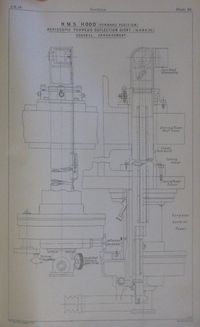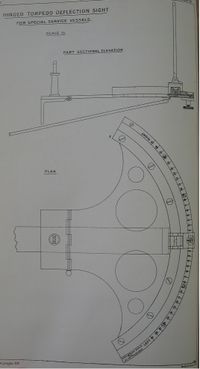Category:Torpedo Deflection Sight
After many years of incremental improvements in its torpedo sighting, in 1912, "various systems of adjusting the director, without necessarily ascertaining the actual course and speed of the enemy, have been brought forward, and are under trial at sea."[1] Knowing (or estimating) the direction and speed of the enemy had always been a hard requirement to aim a torpedo in the Royal Navy. Some fundamentals were being brought into question.
By 1915, the Royal Navy was not happy with its Torpedo Directors, which combined calculating functions based on the director triangle with the sighting function. It devised a family of Torpedo Deflection Sights of several Marks (the first three of which were from modified torpedo directors, the subsequent Marks purpose-made sights) which sought to encompass only the simple task of sighting, leaving the task of calculating the director angle to external means.[2] In 1916, work was rapidly undertaken to design and manufacture various deflection sights.[3] It is not precisely known when these conversions took place, but mention of torpedo directors and how their enemy speed settings should be fudged by different destroyers within an attacking division to achieve a spread of torpedoes is found in the Grand Fleet Battle Orders in effect at the time of the Battle of Jutland, provides some evidence that the change really took hold after the pivotal battle.[4]
The rationale for the change to T.D.Ses. can be found in the Handbook of Torpedo Control, 1916. The germ of it is that the navy concluded that since there were many parameters to set on a director, and the output of these was simply a director angle, it was determined that sending the director angle (expressed as torpedo deflection) to the sighting apparatus was the simplest choice. The discovery of this rationale in the 1916 handbook surprises me, given the lack of any mention of the need to change the director model in any Annual Reports of the Torpedo School in the preceding years.
Geometric Model
The deflection sights worked on the deflection triangle — that formed by the line-of-sight, the path of torpedo, and the line perpendicular to line-of-sight that passes through the point of impact. That last line is the Torpedo Deflection, or speed-across attributable to enemy motion.
The charm seen in such a geometric model is that for any given speed of torpedo, a single scale can be etched along an arc that converts torpedo deflection to the suitable director angle. This means a director's proper setting can be communicated quickly and according to a measure (enemy speed-across) that might be roughly guessed with some accuracy in an emergency.
Mark I
- Main article: Torpedo Deflection Sight Mark I
This was the name given to all A.W. directors converted to being deflection sight, and by the end of August, 1918, had been widely to tubes light cruisers "Attentive" and after and TBDs "E" class and after armed with RGF and RNTF heaters.
Mark II
- Main article: Torpedo Deflection Sight Mark II
Designed in 1916, Mark II sights were line of sight directors modified to deflection sights. By August, 1918, they had been issued to destroyers for use on the bridge, except in "V" class and later which have T.D.S. Mark III in this position. In 1921, it was approved that those remaining in use in "R" class destroyers should be replaced by Mark III.
Mark III
- Main article: Torpedo Deflection Sight Mark III
These were universal sights created by altering existing circular torpedo directors and were for use on light cruisers and destroyers. They featured a sighting telescope and a Clear Range Indicator mechanism.
Mark IV Types
- Main article: Torpedo Deflection Sight Mark IV
This was a family of telescopic (later, periscopic) sights for placement in armoured control positions of capital ships. The periscope would peep out through the slot while the operator enjoyed some measure of protection from gun blast. An open sight alongside was helpful in poor visibility conditions.
Mark V
- Main article: Torpedo Deflection Sight Mark V
The Mark V had just a single deflection ring, bearing the letter designation of a C in a circle, etched for the 26.75-27.25 knot setting of the 18-in Mark IV and the 14-in R.G.F. Mark X*. By 1920, the need for such sights had disappeared, but some of these were modified for use in modern battleships as T.D.S. Mark V*.[5]
Mark VI
- Main article: Torpedo Deflection Sight Mark VI
This sturdy, foldable sight was intended for emergency use at fixed above water tubes on capital ships. It featured an integral clear range indicator mechanism.
Mark VII
- Main article: Torpedo Deflection Sight Mark VII
These periscopic sights could look out through the horizontal view slot of an armoured space on a battleship or battlecruiser and thus permit the operator to avoid gun blast.
Mark VIII
In 1919 and 1920, this sight was still in the design stage and harmony of thought was proving difficult to achieve. It was intended for principal control officers in capital ships. At its core, it would be similar to a T.D.S. Mark III, but with two clear arc indicators to show the arcs of 70 degrees to 110 degrees from friendly capital ships. A gyro ring worked by a milled head would permit fire to be ordered on any gyro bearing within the clear arc limits.[6][7]
Mark IX

This was an altered form of the Mark VII sight, tweaked for use in the forward T.C.T. of Hood based on insights gained from the Mark VII in Courageous. It offered an "angular movement" in the upper prisms with a field of view of at least 10 degrees, markings for the 35 knot speed setting, precautions against fogging, a spray exclusion skirt. The reflected "deflection" and "gyro angle" scales were also omitted.[9]
Sight for Special Service Vessels

Generally similar to the Mark V sight, this sight was optimized for use in Q-ships by working with the smallest possible sighting hole, to avoid detection. The foresight was fixed and to be placed very near the aperture, and the rear sight able to move over an arc. The rear sight was especially long to overcome rolling or if the Q-ship had a heavy list on it, and it was made extra durable.[11]
Sight for C.M.B.s

Despite the name, this device is actually a torpedo deflection sight.
This deflection sight was created for use by Combat Motor Boats. Strength and simplicity were the primary qualities. In the image. the sight bar C could be rotated about the quadrant. The fore sight had a Radiomir element for night firing, and the tips of the rear sight were also radiofluorescent. The deflection scale was marked for 41 knot torpedoes. Later boats were marked for 35 knot torpedoes, but it is not clear whether this was in lieu of or in addition to the 41 knot scaling. A second detachable plate X had markings for a 29 knot speed setting.
Deflection was set as simply as lifting up the forward end of the sight bar and allowing a spring pin to engage the index hole for the desired deflection in knots on the A smaller radial scale could be used to take bearings or observe the director angle, and the sights could fold down when not in use.[13]
In 1919, a redesign of the sight was started to address minor faults by including some features of the Mark VI sight.[14][15]
See Also
Footnotes
- ↑ Annual Report of the Torpedo School, 1912. p. v.
- ↑ Annual Report of the Torpedo School, 1915. pp 60-61.
- ↑ Annual Report of the Torpedo School, 1916. p 25.
- ↑ Golding. Grand Fleet Battle Orders. Destroyer Addendum dated 1/10/15, p. 2.
- ↑ Annual Report of the Torpedo School, 1920. p. 77.
- ↑ Annual Report of the Torpedo School, 1918. p. 160.
- ↑ Annual Report of the Torpedo School, 1919. p. 112.
- ↑ Annual Report of the Torpedo School, 1919. Plate 44.
- ↑ Annual Report of the Torpedo School, 1919. p. 112.
- ↑ Annual Report of the Torpedo School, 1917. Plate 54.
- ↑ Annual Report of the Torpedo School, 1917. p. 191.
- ↑ Annual Report of the Torpedo School, 1918. Plate 115.
- ↑ Annual Report of the Torpedo School, 1918. pp. 160-161.
- ↑ Annual Report of the Torpedo School, 1919. p. 112.
- ↑ Annual Report of the Torpedo School, 1918. p. 159.
Bibliography
- H.M.S. Vernon. (Jan 1916) Annual Report of the Torpedo School, 1915. C.B. 1166. Copy 1025 at The National Archives. ADM 189/35.
- Admiralty, Gunnery Branch (1917). Handbook of Torpedo Control, 1916. C.B. 302. Copy No. 141 at The National Archives. ADM 186/381.
- H.M.S. Vernon. Annual Report of the Torpedo School, 1917. Originally C.B. 1474. Copy 7 at The National Archives. ADM 189/37.
- H.M.S. Vernon. Annual Report of the Torpedo School, 1918. C.B. 1527. Copy 143 at The National Archives. ADM 189/38.
Pages in category "Torpedo Deflection Sight"
The following 7 pages are in this category, out of 7 total.